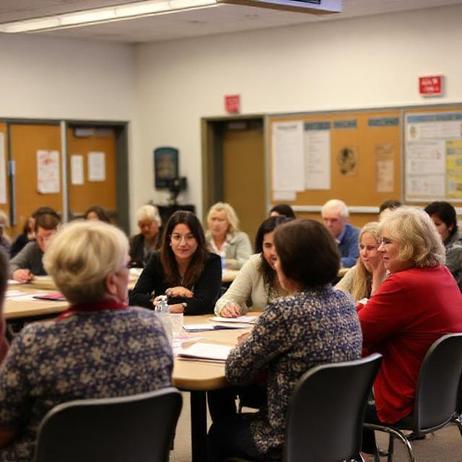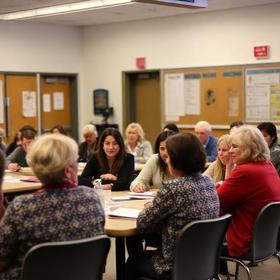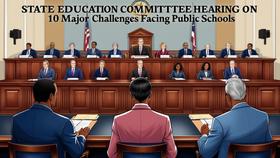Adult Education & Community Programs Offered by Public Schools
Adult Education & Community Programs Offered by Public Schools play a critical role in helping adults access new skills, prepare for the workforce, and strengthen community engagement. In communities across the United States, public school districts have expanded these programs to meet evolving economic, social, and technological needs. As districts rethink how to serve learners of every age, Adult Education & Community Programs Offered by Public Schools have become central to local workforce development, family literacy, and lifelong learning.
Public schools already serve as anchor institutions, so extending services to adult learners is a natural evolution of their mission. The following report examines the most common Adult Education & Community Programs Offered by Public Schools, their impact on local communities, and how districts structure programming to support diverse populations. It also highlights 2025 trends in adult learning, blended instruction, and community partnerships.
PublicSchoolReview.com provides additional context about district-level innovation and community outreach initiatives, including how public schools adapt programming to meet local demand. These insights align with the growing interest in Adult Education & Community Programs Offered by Public Schools.
Why Public Schools Are Expanding Adult Education
Adult Education & Community Programs Offered by Public Schools respond to clear economic and social needs. Districts often launch programs to address:
Gaps in workforce preparedness
Demand for English language learning
Need for retraining among adults shifting careers
Family literacy for parents supporting student learning
Community enrichment and civic engagement
Because public schools already operate buildings, transportation networks, and administrative systems, offering Adult Education & Community Programs Offered by Public Schools is efficient and cost effective. Many districts collaborate with local employers, community colleges, and libraries to broaden access and keep tuition low or free.
Workforce boards and state agencies, including those profiled by the American Association for Adult and Continuing Education, help districts access federal and state funding dedicated to Adult Education & Community Programs Offered by Public Schools.
Core Types of Adult Education Programs Public Schools Offer
Although programs vary by district size and local demand, most Adult Education & Community Programs Offered by Public Schools fall into the following categories.
Adult Basic Education and Literacy
Adult Education & Community Programs Offered by Public Schools frequently begin with foundational literacy. These classes support adults who need stronger reading, writing, and math skills for employment or daily life. Instruction often includes:
Reading comprehension
Functional writing
Basic math and numeracy
Digital literacy essentials
Many districts integrate these programs with workforce readiness training so adults can move directly into career pathways.
High School Diploma and High School Equivalency Preparation
One of the most widely used Adult Education & Community Programs Offered by Public Schools is high school completion. Schools offer pathways that include:
Traditional diploma coursework
High school equivalency preparation
Testing center access
Academic advising
More than one million adults pursue diplomas or equivalency credentials each year nationwide. Districts that collaborate with community colleges often provide seamless transitions into certificate programs.
English as a Second Language (ESL) Programs
ESL programming is an essential component of Adult Education & Community Programs Offered by Public Schools. ESL classes help adults develop conversational English, reading skills, and workplace vocabulary. Schools often offer:
Beginning, intermediate, and advanced ESL
Citizenship preparation
Integrated language and job-skills instruction
Many schools coordinate ESL instruction with family literacy initiatives, allowing parents and children to participate simultaneously. PublicSchoolReview.com has reported on successful ESL models within K–12 systems, particularly in multilingual communities.
Career and Technical Education for Adults
Career and Technical Education, or CTE, is a growing pillar of Adult Education & Community Programs Offered by Public Schools. Districts have expanded adult access to:
Healthcare certifications
Skilled trades and apprenticeships
Information technology training
Early childhood education credentials
Business office skills
CTE labs already exist in many high schools, so offering evening or weekend access for adults increases utilization and strengthens community partnerships. Employers often co-develop curricula to ensure alignment with local labor market needs.
A helpful overview of public school CTE pathways is available at https://www.publicschoolreview.com, which includes profiles of districts pioneering new workforce initiatives.
Family Literacy and Parent Education
Family-focused models are a key part of Adult Education & Community Programs Offered by Public Schools. These programs help parents support student learning and reinforce academic progress at home. Components often include:
Parent ESL
Reading strategies for families
Understanding school curriculum and standards
Digital learning navigation
Districts report that parent education programs improve student outcomes because families become more equipped to participate in school life and academic planning.
Community Enrichment and Lifelong Learning
Many public schools go beyond core academic programs to offer broader Adult Education & Community Programs Offered by Public Schools such as:
Art, music, and creative writing workshops
Technology classes for seniors
Personal finance and consumer education
Wellness, nutrition, and fitness courses
These enrichment programs strengthen school-community relationships and help districts maintain public engagement.
How Public Schools Structure Adult Education Programs
The organization of Adult Education & Community Programs Offered by Public Schools varies, but common structures include:
District Continuing Education Departments
Large districts often operate dedicated continuing education departments that oversee programming, scheduling, instructors, and partnerships. These departments serve as community hubs.
Evening and Weekend Schedules
Because adult learners typically work full time, most Adult Education & Community Programs Offered by Public Schools operate outside standard school hours. Some programs run in hybrid or fully online formats to increase accessibility.
Use of School Facilities
Adult classes typically use schools that already have specialized equipment, such as science labs, CTE workshops, or computer labs. This allows Adult Education & Community Programs Offered by Public Schools to offer high-quality instruction at lower cost.
Partnership Models
Districts frequently collaborate with:
Community colleges
Local employers
Workforce development agencies
Public libraries
These partnerships expand the reach of Adult Education & Community Programs Offered by Public Schools while reducing redundancy. CommunityCollegeReview.com has documented how community colleges partner with districts to streamline adult learner transitions into credit-bearing programs.
Benefits of Adult Education & Community Programs Offered by Public Schools
Adult Education & Community Programs Offered by Public Schools provide measurable benefits to individuals and communities.
Economic Mobility
Adults gain new credentials, improve earning potential, and qualify for sustainable career pathways. This strengthens local economies and reduces unemployment.
Stronger Family Engagement
Programs that support parents strengthen home-school communication and increase parent confidence in navigating education systems.
Community Cohesion
Public schools serve as unifying community spaces. Offering Adult Education & Community Programs Offered by Public Schools fosters civic engagement and builds trust between schools and families.
Intergenerational Impact
When adults improve skills, children benefit from academically enriched home environments. This dynamic supports long-term educational attainment.
2025 Trends Shaping Adult Education in Public Schools
Several developments are influencing the direction of Adult Education & Community Programs Offered by Public Schools in 2025:
Growth of Hybrid Instruction
Districts are expanding flexible formats that blend in-person and online learning, especially for working adults.
Short-Term Credentials
Rapid credentialing, often in partnership with community colleges, is reshaping how adults access training.
Expanded Digital Literacy
Because nearly all workplaces require digital competency, districts are strengthening technology components within Adult Education & Community Programs Offered by Public Schools.
Targeted Programming for New Americans
Programs designed for newcomers include ESL, citizenship preparation, and workforce orientation tailored to local industries.
Use of Data for Program Planning
Districts increasingly analyze enrollment patterns, job market data, and community demographics to refine Adult Education & Community Programs Offered by Public Schools.
Sample Comparison of Common Program Types
| Program Type | Typical Duration | Primary Audience | Key Outcomes |
|---|---|---|---|
| Adult Basic Education | Ongoing | Adults seeking core skills | Improved literacy and numeracy |
| High School Equivalency | 3 to 12 months | Adults without diplomas | Diploma or equivalency credential |
| ESL | Semester-based | English learners | Language fluency and civic readiness |
| CTE for Adults | 6 weeks to 1 year | Career changers, job seekers | Industry certification |
| Enrichment Courses | Short sessions | Community members | Personal growth and engagement |
How Families and Adults Can Access Programs
Individuals interested in Adult Education & Community Programs Offered by Public Schools typically begin by contacting their district’s continuing education office. Many districts maintain online course catalogs, registration portals, and advisors who help adults determine the right pathway. For a deeper look at district structures and offerings, https://www.publicschoolreview.com provides profiles of schools and programs nationwide.
Adults should consider:
Schedule needs
Language support
Financial aid or free tuition
Career alignment
Long-term educational goals
Most programs enroll on a rolling basis so learners can begin throughout the year.
Conclusion
Adult Education & Community Programs Offered by Public Schools have become essential to lifelong learning, workforce preparation, and community development. As districts expand programming to meet 2025 needs, adults benefit from flexible schedules, career-aligned training, and supportive environments designed to reduce barriers to education. Whether seeking a diploma, learning English, gaining a professional certificate, or exploring personal interests, adults increasingly turn to public schools as trusted providers of education and opportunity.
Public schools will continue to serve as community anchors, and Adult Education & Community Programs Offered by Public Schools will remain vital to strengthening families, supporting economic growth, and enhancing civic life.















